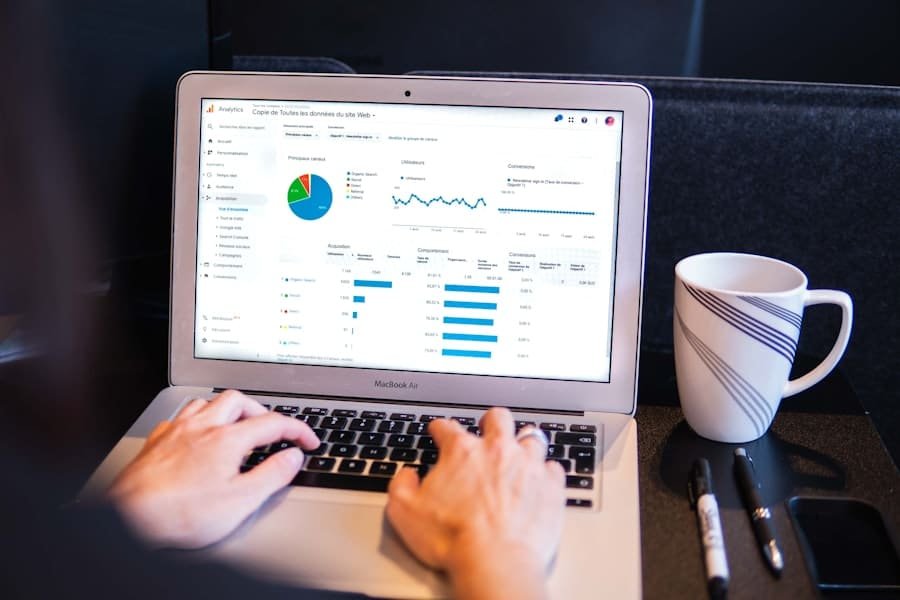Digital Marketing Return on Investment (ROI) is a critical metric that allows businesses to evaluate the effectiveness of their marketing efforts in relation to the costs incurred. It provides insights into how well marketing strategies are performing and whether they are generating sufficient revenue to justify the investment. The calculation of ROI in digital marketing typically involves comparing the net profit generated from marketing activities against the total costs associated with those activities.
This can include expenses related to advertising, content creation, social media management, and other promotional efforts. A positive ROI indicates that the marketing strategy is successful, while a negative ROI suggests that adjustments may be necessary. To grasp the full significance of digital marketing ROI, it is essential to consider the various channels and tactics involved.
For instance, social media campaigns may yield different returns compared to email marketing or pay-per-click advertising. Each channel has its unique audience and engagement metrics, which can influence overall performance. Furthermore, the time frame for measuring ROI can vary; some campaigns may show immediate results, while others may take longer to manifest.
Understanding these nuances allows marketers to make informed decisions about where to allocate resources and how to refine their strategies for optimal results.
Summary
- Digital marketing ROI is the measure of the effectiveness of digital marketing efforts in generating revenue and achieving business objectives.
- Setting clear goals and KPIs is essential for measuring the success of digital marketing campaigns and ensuring alignment with overall business objectives.
- Utilising data and analytics helps in understanding customer behaviour, identifying trends, and making data-driven decisions to improve digital marketing performance.
- Optimising campaign performance involves refining strategies, targeting the right audience, and allocating resources effectively to maximise ROI.
- Implementing A/B testing allows for comparing different versions of digital marketing assets to determine which performs better and make informed decisions for future campaigns.
- Leveraging automation and AI tools can streamline digital marketing processes, improve efficiency, and personalise customer experiences at scale.
- Integrating multi-channel strategies ensures a cohesive and consistent brand presence across various digital marketing channels to reach and engage with a wider audience.
- Continuous monitoring and adaptation involve regularly tracking and evaluating digital marketing performance, and making necessary adjustments to optimise ROI and achieve long-term success.
Setting Clear Goals and KPIs
Establishing clear goals and Key Performance Indicators (KPIs) is fundamental to measuring the success of any digital marketing initiative. Goals should be specific, measurable, achievable, relevant, and time-bound (SMART). For example, a business might set a goal to increase website traffic by 30% over the next quarter.
This goal is not only quantifiable but also provides a clear target for the marketing team to aim for. By defining such objectives, organisations can align their marketing strategies with broader business aims, ensuring that every campaign contributes to overall growth. KPIs serve as benchmarks for assessing progress towards these goals.
Common KPIs in digital marketing include conversion rates, click-through rates, customer acquisition costs, and customer lifetime value. By tracking these metrics, marketers can gain insights into what is working and what isn’t. For instance, if a campaign is generating high traffic but low conversions, it may indicate issues with the landing page or the offer being presented.
Regularly reviewing these KPIs allows teams to pivot quickly and make data-driven decisions that enhance performance.
Utilising Data and Analytics

In the realm of digital marketing, data and analytics play a pivotal role in shaping strategies and driving results. The vast amount of data generated through online interactions provides marketers with invaluable insights into consumer behaviour, preferences, and trends. By leveraging tools such as Google Analytics, marketers can track user engagement on their websites, monitor traffic sources, and analyse demographic information.
This data enables businesses to tailor their marketing efforts to better meet the needs of their target audience. Moreover, advanced analytics techniques such as predictive modelling and segmentation can further enhance understanding of customer behaviour. For instance, by segmenting audiences based on past purchasing behaviour or engagement levels, marketers can create more personalised campaigns that resonate with specific groups.
This targeted approach not only improves engagement rates but also increases the likelihood of conversions. As data continues to evolve, integrating machine learning algorithms can provide even deeper insights, allowing marketers to anticipate trends and adjust their strategies proactively.
Optimising Campaign Performance
Optimising campaign performance is an ongoing process that requires constant evaluation and adjustment. Marketers must analyse various elements of their campaigns, including ad copy, visuals, targeting parameters, and budget allocation. A/B testing is one effective method for determining which variations yield the best results.
By running two versions of an ad simultaneously—one with a specific headline and another with a different one—marketers can identify which resonates more with their audience. Additionally, optimising landing pages is crucial for improving conversion rates. A well-designed landing page that aligns with the ad’s messaging can significantly enhance user experience and encourage visitors to take action.
Factors such as page load speed, mobile responsiveness, and clear calls-to-action all contribute to a successful landing page. Regularly reviewing analytics data allows marketers to pinpoint areas for improvement and implement changes that drive better performance over time.
Implementing A/B Testing
A/B testing is a powerful tool in the digital marketer’s arsenal, enabling them to make data-driven decisions that enhance campaign effectiveness. This method involves comparing two versions of a marketing asset—be it an email, landing page, or advertisement—to determine which performs better in achieving specific objectives. The process begins by identifying a variable to test, such as subject lines in emails or button colours on a landing page.
By isolating this variable and measuring its impact on user behaviour, marketers can gain valuable insights into what resonates with their audience. The implementation of A/B testing should be systematic and well-planned. It is essential to establish clear hypotheses before conducting tests; for example, one might hypothesise that changing the call-to-action from “Sign Up Now” to “Join Our Community” will increase click-through rates.
After running the test for a sufficient duration to gather statistically significant data, marketers can analyse the results and draw conclusions. Successful A/B tests not only inform future campaigns but also foster a culture of experimentation within marketing teams, encouraging continuous improvement.
Leveraging Automation and AI

The integration of automation and artificial intelligence (AI) into digital marketing strategies has revolutionised how businesses engage with their audiences. Automation tools streamline repetitive tasks such as email marketing campaigns, social media posting, and lead nurturing processes. This not only saves time but also ensures consistency in messaging across various channels.
For instance, automated email sequences can be set up to nurture leads based on their interactions with a brand’s website or previous communications. AI takes this a step further by enabling more sophisticated data analysis and personalisation efforts. Machine learning algorithms can analyse vast datasets to identify patterns in consumer behaviour that may not be immediately apparent to human analysts.
This capability allows marketers to deliver highly personalised content at scale—such as product recommendations based on past purchases or tailored advertisements based on browsing history. By leveraging these technologies, businesses can enhance customer experiences and drive higher engagement rates.
Integrating Multi-channel Strategies
In today’s digital landscape, consumers interact with brands across multiple channels—be it social media, email, websites, or mobile apps. Therefore, integrating multi-channel strategies is essential for creating a cohesive customer journey that maximises engagement opportunities. A well-executed multi-channel approach ensures that messaging is consistent across platforms while also allowing for tailored content that suits each channel’s unique characteristics.
For example, a brand might use social media platforms for brand awareness while employing email marketing for lead nurturing and conversion efforts. By tracking user interactions across these channels, marketers can gain insights into how customers move through the sales funnel and adjust their strategies accordingly. Additionally, retargeting ads can be employed to re-engage users who have shown interest but have not yet converted.
This holistic approach not only enhances brand visibility but also fosters stronger relationships with customers by providing them with relevant content at every stage of their journey.
Continuous Monitoring and Adaptation
The digital marketing landscape is dynamic; therefore, continuous monitoring and adaptation are vital for sustained success. Marketers must remain vigilant in tracking performance metrics and analysing market trends to identify shifts in consumer behaviour or emerging opportunities. Regularly reviewing campaign performance allows teams to spot underperforming areas quickly and make necessary adjustments before significant resources are wasted.
Adaptation goes beyond mere reaction; it involves proactively seeking out new strategies and technologies that can enhance marketing efforts. For instance, staying abreast of changes in search engine algorithms or social media platform updates can provide businesses with a competitive edge. Furthermore, soliciting feedback from customers through surveys or social listening tools can offer valuable insights into their preferences and pain points.
By fostering a culture of agility within marketing teams—where experimentation is encouraged and learning from failures is embraced—businesses can navigate the complexities of the digital landscape more effectively and drive long-term growth.
If you are interested in learning more about effective digital marketing strategies for small businesses, you should check out the article Effective Digital Marketing Strategies Any Small Businesses Can Turn To. This article provides valuable insights into how small businesses can leverage digital marketing to reach their target audience and drive growth. It complements the topic of Digital Marketing ROI Optimisation by offering practical tips and strategies for businesses looking to improve their online presence and increase their return on investment.
FAQs
What is Digital Marketing ROI Optimisation?
Digital Marketing ROI (Return on Investment) optimisation refers to the process of improving the effectiveness and efficiency of digital marketing efforts in order to maximise the return on investment. This involves analysing and improving various aspects of digital marketing campaigns to ensure that they are generating the highest possible return for the resources invested.
Why is Digital Marketing ROI Optimisation important?
Digital Marketing ROI Optimisation is important because it allows businesses to make the most of their digital marketing budgets. By continuously improving the performance of digital marketing campaigns, businesses can ensure that they are getting the best possible return on their investment, ultimately leading to increased revenue and profitability.
What are the key components of Digital Marketing ROI Optimisation?
The key components of Digital Marketing ROI Optimisation include tracking and analysing key performance indicators (KPIs), such as conversion rates, click-through rates, and cost per acquisition. It also involves testing and optimising various elements of digital marketing campaigns, such as ad creatives, targeting, and messaging, to improve their effectiveness.
How can businesses improve their Digital Marketing ROI?
Businesses can improve their Digital Marketing ROI by implementing a data-driven approach to their digital marketing efforts. This involves using analytics and tracking tools to measure the performance of campaigns, testing different strategies and tactics, and continuously optimising based on the results. Additionally, businesses can focus on targeting the right audience, creating compelling content, and ensuring a seamless user experience to improve ROI.
What are some common challenges in Digital Marketing ROI Optimisation?
Some common challenges in Digital Marketing ROI Optimisation include accurately attributing conversions to the correct marketing channels, understanding the customer journey across multiple touchpoints, and staying updated with the latest digital marketing trends and technologies. Additionally, balancing short-term and long-term ROI goals can also be a challenge for businesses.
